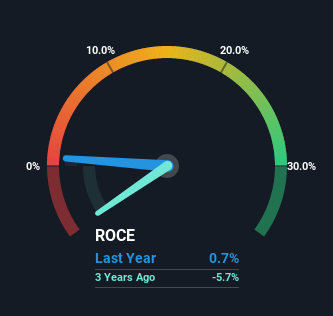Prismaflex International (EPA:ALPRI) Has Some Difficulty Using Its Capital Effectively

To avoid investing in a business that's in decline, there's a few financial metrics that can provide early indications of aging. When we see a declining return on capital employed (ROCE) in conjunction with a declining base of capital employed, that's often how a mature business shows signs of aging. Basically the company is earning less on its investments and it is also reducing its total assets. In light of that, from a first glance at Prismaflex International (EPA:ALPRI), we've spotted some signs that it could be struggling, so let's investigate.
Understanding Return On Capital Employed (ROCE)
For those who don't know, ROCE is a measure of a company's yearly pre-tax profit (its return), relative to the capital employed in the business. To calculate this metric for Prismaflex International, this is the formula:
Return on Capital Employed = Earnings Before Interest and Tax (EBIT) ÷ (Total Assets - Current Liabilities)
0.0072 = €141k ÷ (€46m - €26m) (Based on the trailing twelve months to March 2022).
So, Prismaflex International has an ROCE of 0.7%. In absolute terms, that's a low return and it also under-performs the Media industry average of 13%.
View our latest analysis for Prismaflex International

Historical performance is a great place to start when researching a stock so above you can see the gauge for Prismaflex International's ROCE against it's prior returns. If you'd like to look at how Prismaflex International has performed in the past in other metrics, you can view this free graph of past earnings, revenue and cash flow.
So How Is Prismaflex International's ROCE Trending?
In terms of Prismaflex International's historical ROCE movements, the trend doesn't inspire confidence. To be more specific, the ROCE was 2.1% five years ago, but since then it has dropped noticeably. And on the capital employed front, the business is utilizing roughly the same amount of capital as it was back then. Companies that exhibit these attributes tend to not be shrinking, but they can be mature and facing pressure on their margins from competition. If these trends continue, we wouldn't expect Prismaflex International to turn into a multi-bagger.
On a separate but related note, it's important to know that Prismaflex International has a current liabilities to total assets ratio of 57%, which we'd consider pretty high. This can bring about some risks because the company is basically operating with a rather large reliance on its suppliers or other sorts of short-term creditors. Ideally we'd like to see this reduce as that would mean fewer obligations bearing risks.
The Bottom Line On Prismaflex International's ROCE
All in all, the lower returns from the same amount of capital employed aren't exactly signs of a compounding machine. It should come as no surprise then that the stock has fallen 59% over the last five years, so it looks like investors are recognizing these changes. With underlying trends that aren't great in these areas, we'd consider looking elsewhere.
On a separate note, we've found 2 warning signs for Prismaflex International you'll probably want to know about.
While Prismaflex International may not currently earn the highest returns, we've compiled a list of companies that currently earn more than 25% return on equity. Check out this free list here.
New: Manage All Your Stock Portfolios in One Place
We've created the ultimate portfolio companion for stock investors, and it's free.
• Connect an unlimited number of Portfolios and see your total in one currency
• Be alerted to new Warning Signs or Risks via email or mobile
• Track the Fair Value of your stocks
Have feedback on this article? Concerned about the content? Get in touch with us directly. Alternatively, email editorial-team (at) simplywallst.com.
This article by Simply Wall St is general in nature. We provide commentary based on historical data and analyst forecasts only using an unbiased methodology and our articles are not intended to be financial advice. It does not constitute a recommendation to buy or sell any stock, and does not take account of your objectives, or your financial situation. We aim to bring you long-term focused analysis driven by fundamental data. Note that our analysis may not factor in the latest price-sensitive company announcements or qualitative material. Simply Wall St has no position in any stocks mentioned.
About ENXTPA:ALPRI
Prismaflex International
Designs, manufactures, and sells various advertising supports and wide format digital printing products and solutions worldwide.
Solid track record with adequate balance sheet.
Market Insights
Community Narratives





